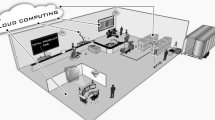Abstract
Although small- and medium-sized enterprises (SMEs) shape the cornerstone of the economy, they encounter various challenges in managing the transition to Industry 4.0. This condition represents an ill-structured problem under uncertainty, which requires a set of specific tools to be solved. This study relies on an integrated approach composed of the interval type-2 fuzzy best–worst method (IT2F-BWM) and the interval type-2 fuzzy decision-making trial and evaluation laboratory (IT2F-DEMATEL) method, to handle the complexities that SMEs experience in the transition to Industry 4.0. The results of the IT2F-BWM revealed the priority of the “organizational” dimension over the “technological” and “strategic” dimensions. Furthermore, the IT2F-DEMATEL results showed that the “organizational” dimension exerted the highest degree of impact. The most effective criteria (sub-dimensions) were “the lack of a skillful management team,” “the need for advanced skills,” and “having insufficient knowledge of and little interest in Industry 4.0 and its outcomes,” which fell under the “organizational,” “technological,” and “strategic” dimensions, respectively. The findings could help firms and enterprises to gain adequate knowledge of Industry 4.0 before implementing it, while clarifying how such entities can enhance their organizations and overcome obstacles by training their human resources.




Similar content being viewed by others
Data availability
Enquiries about data availability should be directed to the authors.
References
Abdul Moktadir Md, Mithun Ali S, Sarpong S, Aftab Ali Shaikh Md (2018) Assessing challenges for implementing Industry 4.0: Implications forprocess safety and environmental protection. Process Saf Environ Prot. https://doi.org/10.1016/j.psep.2018.04.020
Abdullah L, Zulkifli N (2016) Integration of fuzzy AHP and interval type-2 fuzzy DEMATEL: an application to human resource management. Expert Syst APpl 42:4397–4409. https://doi.org/10.1016/j.eswa.2015.01.021
Alimohammadlou M, Khoshsepehr Z (2022a) Green-resilient supplier selection: a hesitant fuzzy multi-criteria decision-making model. Environ Dev Sustain 24(12):1–37. https://doi.org/10.1007/s10668-022-02454-9
Alimohammadlou M, Khoshsepehr Z (2022b) Investigating organizational sustainable development through an integrated method of interval-valued intuitionistic fuzzy AHP and WASPAS. Environ Dev Sustain 24(2):2193–2224
Chou Y, Sun C, Yen H (2012) Evaluating the criteria for human resource for science and technology (HRST) based on an integrated fuzzy AHP and fuzzy DEMATEL approach. Appl Soft Comput 12(1):64–71. https://doi.org/10.1016/j.asoc.2011.08.058
Coupland S, John R (2008) Type-2 fuzzy logic and the modelling of uncertainty. In: Fuzzy sets and their extensions: representation aggregation and models, vol 220. Springer-Verlag, Germany, Berlin, pp 3–22
Damiani L, Demaratini M, Guizzi G, Revetria R, Tonelli F (2018) Augmented and virtual reality applications in industrial systems: a qualitive review towards the industrt 4.0 Era. IFAC PapersOnline 51(11):624–630. https://doi.org/10.1016/j.ifacol.2018.08.388
Frank AG, Dalenogare LS, Ayala NF (2019) Industry 4.0 technologies: implementation patterns in manufacturing companies. Int J Prod Econ 210:15–26. https://doi.org/10.1016/j.ijpe.2019.01.004
Ghobakhloo M (2018) The future of manufacturing industry: a strategic roadmap toward Industry 4.0. J Manuf Technol Manag 29(6):910–936. https://doi.org/10.1108/JMTM-02-2018-0057
Guo S, Zhao H (2017) Fuzzy best-worst multi-criteria decision-making method and its applications. Knowl-Based Syst 121:23–31. https://doi.org/10.1016/j.knosys.2017.01.010
Hamedi M, Zamani-Babgohari, A (2019) Evaluating Industry 4.0 implementation challenges in production companies through the fuzzy best-worst method. In: The 4th industrial management international conference. Yazd University
Khan, A., & Turowski, K. (2016). A perspective on industry 4.0: from challenges to opportunities in production systems. In: Proceedings of the international conference on internet of things and big data (IoTBD 2016), pp 441–448, https://doi.org/10.5220/0005929704410448
Kiel D, Muller JM, Arnold C, Voigt K (2017) Sustainable industrial value creation: benefits and challenges of industry 4.0. Int J Innov Manag. https://doi.org/10.1142/S1363919617400151
Kleindienst M, Ramsauer C (2018) SMEs and industry 4.0—introducing a KPI based procedure model to identify focus areas in manufacturing industry. Athens J Bus Econ 2(2):109–122. https://doi.org/10.30958/ajbe.2-2-1
Luthra S, Kumar Mangla S (2018) Evaluating challenges to Industry 4.0 initiatives for supply chain sustainability in emerging economies. Process Saf Environ Prot 117(2018):168–179. https://doi.org/10.1016/j.psep.2018.04.018
Manda MI, Ben Dhauo S (2019) Responding to the challenges and opportunities in the 4th Industrial revolution in developing countries. In: ICEGOV2019 proceedings of the 12th international conference on theory and practice of electronic governance, Melbourn, pp 244–253. https://doi.org/10.1145/3326365.3326398
Mohamed M (2018) Challenges and benefits of industry 4.0: an overview. Int J Supply Oper Manag 5(3):256–265
Muhuri P, Shukla A, Abraham A (2019) Industry 4.0: a bibliometric analysis and detailed overview. Eng Appl Artif Intell 78:218–235. https://doi.org/10.1016/j.engappai.2018.11.007
Omidi N, Mohammadi A, Pourashraf Y, Khaili K (2018) Analyzing the impacts of the factors affecting the establishment and development of small and medium-sized enterprises in rural areas of Ilam province, Iran. J Space Econ Rural Dev 3(25):145–164
Permadi GS, Vitadiar TZ, Kistofer T, Mujianto AH (2019) The Decision Making Trial and Evaluation Laboratory (Dematel) and Analytic Network Process (ANP) for Learning Material Evaluation System, E3S Web of Conferences 125, https://doi.org/10.1051/e3sconf/2019125ICENIS 2019 2 23011
Ping Lin K, Lang Tseng M, Feng Pai P (2018) Sustainable supply chain management using approximate fuzzy DEMATEL method. Resour Conserv Recycl 128:134–142. https://doi.org/10.1016/j.resconrec.2016.11.017
Rauch E, Matt DT, Brown CA, Towner W, Vickery A, Santiteerakul S (2018) Transfer of industry 4.0 to small and medium sized enterprises. In: Conference: transdisciplinary engineering methods for social innovation of industry 4.0, at Modena (Italy), https://doi.org/10.3233/978-1-61499-898-3-63
Rezaei J (2015) Best-worst multi-criteria decision-making method: Some properties and a linear model. Omega. https://doi.org/10.1016/j.omega.2015.12.001
Safar L, Sopko J, Bednar S, Poklemba R (2018) Concept of SME business model for industry 4.0 environment. TEM J 7(3):626–637. https://doi.org/10.18421/TEM73-20
Schroder C (2017) The challenges of industry 4.0 for small and medium-sized enterprises. Friedrich-Ebert-Stiftung, Bonn
Sevinç A, Gür S, Eren T (2018) Analysis of the Difficulties of SMEs in Industry 40 Applications by Analytical Hierarchy Process and Analytical Network Process. Processes 6, 264, 1–16. https://doi.org/10.3390/pr6120264
Sheng L, Xiao Y, Hu-Chen L, Ping Z (2018) DEMATEL technique: a systematic review of the state-of-the-art literature on methodologies and applications. Math Probl Eng. https://doi.org/10.1155/2018/3696457
Shukla AK, Nath R, Muhuri PK, Lohani QMD (2020) Energy efficient multi-objective scheduling of tasks with interval type-2 fuzzy timing constraints in an Industry 4.0 ecosystem. Eng Appl Artif Intell. https://doi.org/10.1016/j.engappai.2019.103257
Sisinni E, Saifullah A, Han S, Jennehag U, Gidlund M (2018) Industrial internet of things: challenges, opportunities, and directions. IEEE Trans Ind Inform 14(11):4724–4734. https://doi.org/10.1109/TII.2018.2852491
Stancioiu A (2017) The fourth industrial revolution “Industry 4.0.” Rev Fiabil Durabilitate 1(19):74–78
Ulewicz R, Novy F, Sethanan K (2019) The challenges of industry 4.0 for small and medium enterprises in Poland and Slovaki. Qual Prod Improv 1(1):147–154. https://doi.org/10.2478/cqpi-2019-0020
Witkowski K (2017) Internet of things, big data, industry 4.0– innovative solutions in logistics and supply chains management. Procedia Eng 182:763–769. https://doi.org/10.1016/j.proeng.2017.03.197
Wu Q, Zhou L, Chen Y, Chen H (2019) An integrated approach to green supplier selection based on the interval type-2 fuzzy best-worst and extended VIKOR methods. Inf Sci 502:394–417. https://doi.org/10.1016/j.ins.2019.06.049
Funding
The authors declare that no funds, grants, or other support were received during the preparation of this manuscript.
Author information
Authors and Affiliations
Contributions
All authors contributed to the study conception and design. Material preparation, data collection, and analysis were performed by MA and SS. The first draft of the manuscript was written by SS, and MA commented on previous versions of the manuscript. MA read and approved the final manuscript.
Corresponding author
Ethics declarations
Competing interests
The authors declare that there is no conflict of interests regarding the publication of this paper.
Ethical approval
This article does not contain any studies with human participants or animals performed by any of the authors.
Additional information
Publisher's Note
Springer Nature remains neutral with regard to jurisdictional claims in published maps and institutional affiliations.
Rights and permissions
Springer Nature or its licensor (e.g. a society or other partner) holds exclusive rights to this article under a publishing agreement with the author(s) or other rightsholder(s); author self-archiving of the accepted manuscript version of this article is solely governed by the terms of such publishing agreement and applicable law.
About this article
Cite this article
Alimohammadlou, M., Sharifian, S. Industry 4.0 implementation challenges in small- and medium-sized enterprises: an approach integrating interval type-2 fuzzy BWM and DEMATEL. Soft Comput 27, 169–186 (2023). https://doi.org/10.1007/s00500-022-07569-9
Accepted:
Published:
Issue Date:
DOI: https://doi.org/10.1007/s00500-022-07569-9




